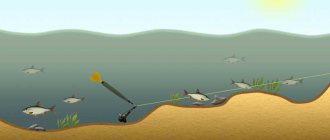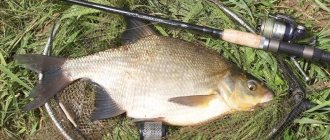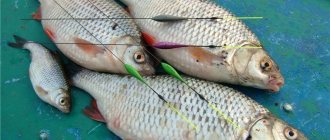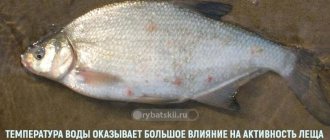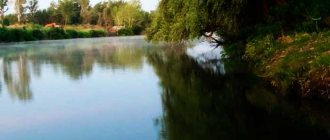Bream is the main synonym for feeder fishing, because it is for catching this fish that the latest techniques and tactics for feeding places, devices and a huge amount of gear have been developed.
It is in August, when the nights become longer and the water temperature constantly changes, that the time comes to catch large individuals of this species.
In the last month of summer, an amazing time begins - fish flock together and feed intensively, and the process takes place in classic places with shallow depths, which gives every fisherman a great chance to catch the fish he dreamed of.
Choosing a fishing spot for catching bream in August
Promising places are straight river runs, where a smooth current prevails and which are formed at the exit from the pits.
In general, such places are a real paradise for fishing, because a huge amount of fish accumulates in them, not only bream, but also other representatives.
Exits to pits are also excellent for catching bream, since in such places a huge amount of food accumulates, which attracts fish.
In such places, the bottom is characterized by a broken topography with complex jets, which is especially to the taste of fish.
Effective catches can also be found in still waters with little rip current. In such places, a fairly large depth is formed and many large individuals are always present.
Also a good place for fishing are the oxbow lakes adjacent to the river. In most cases, such reservoirs are not deep and therefore warm up well, due to which there is a large growth of microorganisms in them, which is what the fish feed on.
If we talk about lake fishing, it should be noted that finding a place in a lake where a large number of fish accumulates is very problematic, with the exception of cases of coastal fishing.
Bream prefers to go out to water bodies in search of food, and if their depth reaches no more than two meters, then the fisherman’s chances of catching a large representative increase significantly.
Fishing for carp on a feeder in August
The first thing I do when catching carp with a feeder when I arrive at a commercial reservoir is preparing a special bait mixture. Most often, to attract voracious active carp, it consists of very high-quality nutritional ingredients. I don’t trust homemade food, but use ready-made professional bait created specifically for carp fishing. The most popular ones now are those that contain fishmeal, green-lipped clams and the attractant betaine green. Products containing hemp, flax and peanuts are also valued, especially if they are flavored with CSL attractant and corn flavoring. One of the latest tricks is playing on taste and aromatic contrasts, creating complex multi-component mixes from products that do not seem compatible at first glance. Based on the experience of last year, I discovered a trouble-free combination of fish and corn baits, filled with a persistent, highly concentrated corn flavoring. Such bait, unusual in smell and taste, may not be very pleasant to humans, but carp really like it and works well.

For carp fishing, I prepare a couple of feeder rods, but I fish with only one: I simply duplicate the other one, which has the same equipment, but with a longer leash. To catch medium and large carp, I choose long feeder rods with complex English action Granito 424 medium light from the Italian company Bnscoia. This quivertype has excellent working qualities: the solid length of the elegant blank allows you to work at medium and long ranges, very accurately sending small and medium weight feeders and weights. A very durable blank makes it possible to cast a feeder with a weight of 60 g or more, and when power and long-distance casting is required, the rod does it with ease. The non-standard length of a medium-class rod allows you to overcome underwater edges, shell rock ridges and algae fences; after all, the longer the rod is, the higher the angle at which the feeder emerges from under the water. A long feeder makes it easier to bring large fish to the surface and, thanks to the impressive leverage, subdue them. and the parabolic action gives confidence when fishing for a trophy.
Read: Fishing for fish
On commercial reservoirs, where the catch-and-release principle is observed, there are many carp that have already been pierced by hooks, which are best caught with a very sensitive equipment called Helicopter arnd two knots. At the same time, the fish quickly finds baits, so bites occur faster and more often. The sensitivity of the Helicopter and two knots equipment is excellent. The direct connection of the leader to the rig and the lack of retraction speeds up the tension of the line immediately after the fish takes the bait in its mouth. This distinguishes this equipment from the Gardner loop, which has a shoulder. Although the absence of a shoulder increases the sensitivity of the rig, the fish on this rig feel the tension of the line from the tip to the feeder, so they often throw the bait without having time to swallow it. There are two ways to combat this: increasing the length of the leash and being extremely attentive to the angler. Having decided to fish with such equipment, you will have to not let go of the rod from your hands and not take your eyes off the feeder tip for a second, reacting with a quick hook to any trembling of the quiver tip.
For some time now I have started using fluorocarbon leashes. They are more effective because they are less visible to fish than regular monofilament line. The use of fluorocarbon in equipment and in leashes increases the number of large fish caught. Such leashes are more resistant to abrasive effects, that is, they can be used to fish on cluttered and shell-ridden bottoms. The low visibility of fluorocarbon fishing line allows the use of larger diameter leaders for carp fishing, for example 0.2 and even 0.25 mm. The solid diameter of the leash gives you more confidence that the leash will withstand a large fish. Fluorocarbon fishing line is also stiffer, which helps the angler, when hooking, to drive the hook deeper into the fish’s lip, that is, with such leashes there are fewer idle hooks.
Read: 7 best baits for carp fishing
Sometimes the fish bites very carefully and is capricious, although it spins around, tasting the bait. For such picky carp I have one more preparation. The essence of the secret weapon is a special attractive gel with which I flavor the baits. These products are called GOO and come from South Africa. In England, GOO gels created a real sensation. Many British people have set records with them. These products reached Russia only in the middle of last year, and in very limited quantities; I turned out to be one of the lucky owners of such gels. During a year of testing in Russian reservoirs, I managed to catch many large fish. GOO is a new product created by the famous professional fisherman Loutjie Luce from the Republic of South Africa. In his homeland he is called the alchemist of carp fishing. Under his patronage, the South African national team has repeatedly shown fantastic results at the World Carp Fishing Championships.
This attractant is a gel-like viscous mass that can be applied to the bait or added inside the feeder; You can coat a PVA stick or sinker with it. An adhesive gel envelops the object. on which it is applied, and it does not fall off or flow down. When dropped into water, GOO Gel slowly dissolves, forming a cloud around the object on which it is applied, in appearance it resembles billowing smoke or a mini-cloud. In my arsenal, the most effective ones were corn, peach, pineapple and plum gels. Moreover, not only carp, but also bream and crucian carp are excellently caught with them.
Fishing on a feeder
Selection of gear for catching bream in August
Large bream is a fairly lively fish, which affects the choice of gear. When choosing, it is important to pay attention to the performance characteristics of gear, because if you do not show due attention and responsibility, fishing may not end up looking promising.
So, for example, when starting to choose a fishing rod, you need to choose models that reach a length of about 3.6-3.9 meters.
With such rods it is much more convenient and freer to make long casts, especially at night, when visibility conditions for the object are significantly deteriorated.
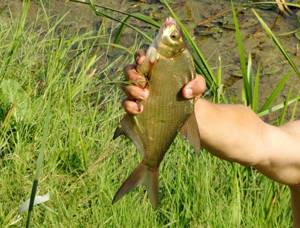
The choice of reel depends on the preferences of the fisherman; it is only worth noting that the most advisable is to buy a reel whose size is at least 4000.
A difficult choice must be made between buying a braided cord or a regular fishing line.
So, for fishing at a distance of up to 25 meters, a regular fishing line is suitable, since its excessive stretchability will not have a negative impact on the fishing process.
If you plan to fish at a distance of more than 25 meters, then it is best to give preference to a braided cord, but the diameter should be chosen as small as possible.
The length of the leash also plays an important role, so you need to choose it carefully and thoughtfully.
Fishing technique and tactics
Typically, 2 or 3 feeders are used at once for catching bream. They can be installed both in still water and in currents, the main thing is to position them correctly. The feeders are placed along the flow. The last one is cast at an angle of 50° relative to the shore, the middle one - 80°, the last one - 110°. If the current is very strong, then it is better to dive closer to the direction of the current. With this approach, there will be less pressure on the line. After casting you should wait 15 minutes. If there is no bite, then the feeders must be removed from the water and the food in them must be replaced. Having waited for the bite, you should fish it out carefully and confidently. You shouldn’t rush too much, but you shouldn’t hesitate either. If there is no bite for a long time (30–50 minutes), then it makes sense to move to another place.
Did you know? In bream, the pharyngeal teeth are formed in rows of 5 pieces. from each side. When absorbing food, the fish's jaws work like a meat grinder.
Using float gear, you can fish the area both from the shore and from a boat. The fishing rod is more suitable for fishing in the morning and evening hours, when it is still light. If with shore fishing everything is simple (you need to throw out the tackle and wait for a bite), then with a boat it will be a little more complicated. You should swim very quietly to the place where the bream is supposed to stay. To do this, it is better to take a non-motorized vehicle. If this is not the case, then it is worth drowning out at a distance of 200 m from the fishing site. Then they swim up on inertia. Then they throw in the bait, and 30 minutes later - the tackle.
Video: fishing for bream in August

Next, the fisherman’s task is to carefully monitor the alarm. As soon as there is a bite, you need to make a sharp hook and confidently bring the fish to the surface of the water, and then fish it out. To prevent your catch from being lost, it is better to always carry a landing net with you. Then, immediately after fishing, you can pick up the catch in it. Donka among fishermen is considered the most catchy tackle for bream. They secure it to the shoreline with a stake.
Find out also how to distinguish a chub from an ide.
Next, they take the main thread with leads by boat and cast. The tackle is taken as far as its length is sufficient. Thus, it is possible to cover a fairly large area. The bite is determined by the degree of tension of the fishing line. It is best to leave this gear overnight and check for the catch in the morning.
August is a hot time for anglers. During this period, bream actively bites on all types of bait. In the last month of summer, it can be caught even with a float rod, and not just with bottom gear.
Bait for catching bream in August
Of course, it is impossible to imagine successful bream fishing in August without the use of effective bait, on which the effectiveness of the bite depends.
If a fisherman has a trusted store that sells high-quality bait from the manufacturer, and he does not have time to prepare the mixture, then he can choose ready-made packages.
If you have time to prepare, then it is best to complete the entire process yourself.
When purchasing ready-made bait, you need to take into account the main criteria:
- type and size of fish;
- type of reservoir;
- method of fishing.
If you plan to prepare bait with your own hands, then you need to take into account all the rules.
So the mixture should not only attract fish, but also keep them for a while.
To attract a flock, you need to prepare bait from the following ingredients:
- breadcrumbs;
- wheat bran;
- ground biscuits;
- corn flour and grits;
- oatmeal or crushed rolled oats;
- roasted and ground sunflower seeds.
Mixing such ingredients is not enough, because you need to moisten the mixture and leave it to steep for 20-30 minutes and then check how it disintegrates in water.
Behavior of crucian carp in August
Crucian carp is a member of the carp family. It is distinguished by a wide body with large, rich scales of a golden or silver tint. This representative of the underwater world can be found almost throughout Russia: from the southern regions to the Urals and Siberia.
Did you know? Crucian carp is considered a very intelligent fish, since it is able to escape from poachers' nets. To do this, he simply lies sideways on the bottom and goes below the level of the set trap. He can also easily fall off the hook if he feels that the bait is much heavier than expected.
This fish likes to settle in reservoirs with stagnant water, a muddy bottom and an abundance of algae, under snags and in bottom depressions. Crucian carp is very thermophilic, but does not tolerate excessive summer heat very well, when the amount of oxygen in the water decreases. That is why, after the July heat, crucian carp can be very voracious and easy to catch, if you take into account some of the features of its behavior.
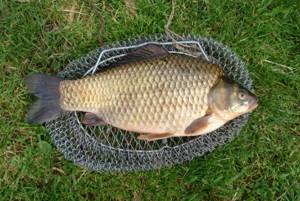
Baits for catching bream
The last month of summer is a kind of stage when fish switches from plant foods to animal foods and is in constant search of food.
Since bream is a rather finicky fish, you need to take a whole arsenal of various attachments and baits with you when fishing so that the fishing is truly effective and your time near the reservoir is not wasted.
To retain bream you need to use the following animal baits:
- bloodworm;
- chopped worms;
- maggot;
- steamed peas;
- canned corn;
- boiled pearl barley porridge;
- semolina chatter.
There are situations when a fisherman baits a spot for several hours, but for unknown reasons the mixture does not attract bream and then the fisherman needs to take a non-standard approach.
You need to use a combination of baits on the hook, for example, you can make a delicious sandwich from maggot and peas, pearl barley and a worm, bloodworms and corn.
If this method does not attract bream, you can try combining two seemingly inedible components: polystyrene foam balls and pieces of scented foam rubber.
Of course, at first glance this combination does not seem promising, but in practice the result is completely opposite.
The method of fishing for bream using boilie carp bait has also proven itself to be very effective.
Catching baits
In August, bream bites on both plant and animal baits; in each individual body of water it is necessary to select a delicacy for it experimentally. What can I offer? At the end of summer you can seduce him:
- red worm;
- leech;
- maggot or caster;
- steamed wheat;
- corn;
- peas;
- dough;
- mask;
- store-bought ottoman (honey, strawberry).
It is advisable to place several worms on the hook. The voluminous bait is visible from afar, in addition, it camouflages the hook well. The same applies to maggots. And with a bunch of worms, the probability of catching a trophy specimen doubles.
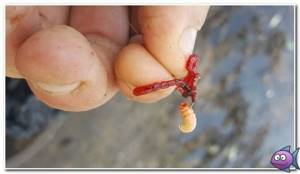
If the target does not pay attention to individual baits, it is worth trying different combinations. For example, plant a grain of corn and a couple of maggots. Sandwiches often save fishing in cases when it begins to seem that it was not a success.
Catching bream on a feeder - features
A feeder is a special fishing rod that resembles a donka known throughout the fishing world, but significantly modernized.
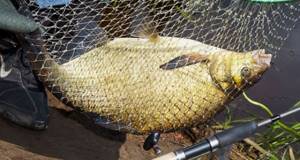
A special feature of the feeder is its lightness, ease of use and efficiency.
In addition, fishing in this way is also available to those who set out to “get” fish for the first time.
Another feature is the all-season nature of the method - you can fish as soon as the ice melts and until it covers the river again.
Properly chosen fishing gear is the key to successful fishing.
So, the best length of a feeder rod is 3 meters, and the reel is at least 3000 powerful, strong and spacious.
In addition, you need to choose other components correctly, for example, the length of the fishing line should be 100-1500 meters, the diameter should be 0.3 millimeters.
A special feature of catching bream on a feeder is the method of feeding it. A certain rule applies here: what the baiting process is for is why you need to catch bream, for example, if maggot is added to the bait, it needs to be put on the hook.
Since bream feed in pit-like places, it is more effective to throw bait above the place where it presumably lives.
What gear is needed for bream?
Since this article is about catching bream with a feeder, we’ll start directly with the question of choosing a feeder rod. Modern manufacturers of fishing products offer a great variety of them. The right choice depends on the intended fishing location. Let's look at specific situations.
Most closed reservoirs have a bottom topography such that casting from the shore to the required depth is not an easy task. The longer the rod, the stronger the casting is possible. Standard feeder rods have a length of 330-390 cm. Choose from this range.
Pay attention to the rod test. It is best if you have a feeder with a test range from 30 to 120 g, for example. In most cases, a coil needs a power of 2500-3000. It is equipped with a braided cord or fluorocarbon line. The cord is acceptable in those reservoirs where the water is not ideally transparent. Flur is recommended for rivers and lakes with clear water. Its refraction in water acts in such a way that the fishing line becomes almost invisible. The diameter of the cord or fishing line must be selected based on the parameters of your fishing rod.
Keep in mind that some braided lines float very strongly in the wind, which will make it difficult for calm fishing. It is enough that the breaking load of the fishing line is 5-6 kg. The fact is that many manufacturers deliberately inflate the coveted figure. In fact, such a line can break even when fishing for a three-kilogram bream. Feeders for standing water are recommended from 20 grams. The form is not important. It is best to choose high-quality, hardened hooks.
For feeder fishing on the river in August, you will need:
- standard rod
- coil
- braided cord
- feeders of the required weight.
- hooks
Keep in mind: the stronger the current, the more massive the feeder should be. Its main task is not only to deliver food and bait to the desired point, but also to stay there. What is the point of feeding if the feeder will be carried away by the current and the complementary food will be dispersed over a large area? On deep rivers, feeders weighing up to 180 grams are used. The feeder rod test must be appropriate!
The shape of the feeder also depends on the complementary food you intend to use. If there are a lot of large elements in it, then the feeder should have large holes so that the food does not linger inside. For a fine-grained mixture, the feeder, if spoiled, should have a dense pattern on the walls. There is no fundamental difference between plastic feeders and metal ones. The only thing is that the first ones are not so strong; it is better not to place them on reservoirs with a rocky bottom. Absolutely any store-bought feeder can be additionally loaded with lead soldering on the back wall: if the shape suits you, but the weight does not.
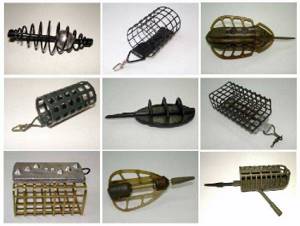
Various feeders
Tip: when choosing a feeder, pay attention to the availability of replaceable quivertypes with different tests. There should be at least three of them, of different sensitivity. This will maintain the overall sensitivity of the gear under different fishing conditions. Each tip is designed for fishing with a feeder in a certain weight range. Let's say up to 30 gr., from 30 to 90, from 90 to 120. Usually they have different colors, which you just need to remember. If the scriber breaks, it can be replaced.
These consumable parts for feeder rods are sold in fishing stores and are standard for most feeders, that is, interchangeable.
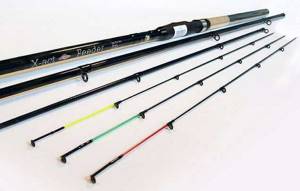
Vertices of different sensitivity
You can either tie the feeder and hook yourself, or you can buy ready-made feeder equipment with an anti-twist and other benefits in the store. They are somewhat more expensive than all their elements separately, but the quality of installation of such equipment is always at its best.
Fishing with a feeder - which feeder to choose?
The choice of feeder is key
Since bream feed in pit-like places, it is more effective to throw bait above the place where it presumably lives.
role, because it is important to choose a high-quality, comfortable and durable model that will ensure successful fishing and will not force the fisherman to sit by the pond for a long time in vain.
There are many models of modern feeders, and choosing just one is not difficult; you just need to look through the review and choose the best model.
You should also pay attention not only to the cost of the feeder, but also to the manufacturer and features.
Review of the best feeders and their features
There are a huge number of feeder models, but among all the models there is a top of the best, which have proven themselves with their excellent performance qualities.
Mikado feeders
This feeder is in demand among fishermen due to its good performance and relatively low price. On the positive side, models whose length reaches up to 3.6 m have proven themselves.
MikadoTwinFeeder models work well; MikadoEverGreenUltraHeavy; Mikado Matrix 777.
Feeders Salmo
The Baltic company Salmo has been producing products for fishing for more than twenty years.
The models produced differ not only in price category, but also in quality.
The most expensive models are: SalmoElite; SalmoDiamond. Budget options include models: SalmoSupreme; SalmoTaifun.
Banax Piccolo feeders
A series of such feeder rods was developed taking into account the characteristics of Russian reservoirs. Such models are equipped with an insert knee, with the help of which the length of the fishing rod can be increased by 50 cm.
Daiwa feeders
If you plan to fish in deep waters, then it is best to pay attention to the DaiwaAqualiteHeavyFeeder.
For professional fishermen, Japanese engineers have released a series of DaiwaTournament F-1 Feeder rods. Such Japanese feeders are distinguished by their lightness, quality, durability and convenience.

